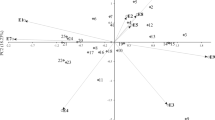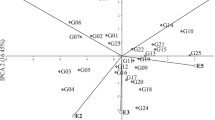Abstract
Multi-environment trials have a fundamental role in selecting the better performing genotypes stable across different environments before its commercial release. Thus, the study was carried out to identify high-yielding stable rapeseed genotypes using different parametric and nonparametric statistics involving 11 new advanced genotypes and 2 cultivars. The genotypes were evaluated in a randomized complete block design with three replications across 12 environments (combination of years and locations) during 2015–2017 growing seasons. The results indicated that genotype, environment and genotype × environment (G × E) effects were significant for seed yield, indicating differential responses of the genotypes to the environments, enabling the stability analysis. According to correlation coefficient and principal components analysis (PCA), the nonparametric measures of Si(2), Si(3), Si(6), NPi(2), NPi(3), NPi(4) and KR were positively and significantly correlated with mean seed yield and thus these measures can be used for selection of the stable genotypes. In general, based on our results four genotypes, G13, G2, G1 and G5 had higher seed yield and stability than control genotypes (G10 and G11). The genotype G13 with the highest yielding and stability performance is the most recommended as promising genotype for commercial release to farmers for cultivation in cold and moderately cold regions of Iran and other similar environments for adoption. Oil content of the genotype G13 was 44.36%. Oleic acid, a prominent component (65.78%) followed by linoleic acid (16.72%) was recognized as the main components in oil content of the genotype G13.


Similar content being viewed by others
References
Akbarpour OA, Dehghani H, Sorkhi-Lalelo B, Kang MS (2016) A SAS macro for computing statistical tests for two-way table and stability indices of nonparametric method from genotype-by-environment interaction. Acta Sci Agron 38:35–50
Alake CO (2018) Genotype × environment interaction effects on pod yield and pod number in West African Okra. Arch Agron Soil Sci 64:1503–1517
Alizadeh K, Mohammadi R, Shariati A, Eskandari M (2017) Comparative analysis of statistical models for evaluating genotype× environment interaction in rainfed safflower. Agric Res 6:455–465
Becker H, Leon J (1988) Stability analysis in plant breeding. Plant Breed 101:1–23
Beyzi E, Gunes A, Beyzi SB, Konca Y (2019) Changes in fatty acid and mineral composition of rapeseed (Brassica napus ssp. oleifera L.) oil with seed sizes. Ind Crops Prod 129:10–14
Chaudhari S, Tikle AN, Patil SB, Kumar S, Saxena K (2020) Genotype× environment interaction for fertility restoration and yield traits in pigeonpea (Cajanus cajan) Hybrids. Agric Res 9(4):508–515
Dehghani MR, Majidi MM, Mirlohi A, Saeidi G (2016) Integrating parametric and non-parametric measures to investigate genotype × environment interactions in tall fescue. Euphytica 208:583–596
Dezfouli PM, Sedghi M, Shariatpanahi ME, Niazian M, Alizadeh B (2019) Assessment of general and specific combining abilities in doubled haploid lines of rapeseed (Brassica napus L.). Ind Crops Prod 141:111754
Dia M, Wehner TC, Arellano C (2016) Analysis of genotype × environment interaction (G× E) using SAS programming. Agron J 108:1838–1852
Ebdon J, Gauch H (2002) Additive main effect and multiplicative interaction analysis of national turfgrass performance trials. Crop Sci 42:497–506
Eberhart ST, Russell W (1966) Stability parameters for comparing varieties 1. Crop Sci 6:36–40
Eckes AH, Gubała T, Nowakowski P, Szymczyszyn T, Wells R, Irwin JA, Horro C, Hancock JM, King G, Dyer SC (2017) Introducing the brassica information portal: towards integrating genotypic and phenotypic brassica crop data. F1000Research 6:465
Finlay K, Wilkinson G (1963) The analysis of adaptation in a plant-breeding programme. Aust J Agric Res 14:742–754
Francis T, Kannenberg L (1978) Yield stability studies in short-season maize. I. A descriptive method for grouping genotypes. Can J Plant Sci 58:1029–1034
Gholizadeh A, Dehghani H (2016) Graphic analysis of trait relations of Iranian bread wheat germplasm under non-saline and saline conditions using the biplot method. Genetika 48:473–486
Gholizadeh A, Dehghani H, Khodadadi M (2019) Quantitative genetic analysis of water deficit tolerance in coriander through physiological traits. Plant Gene Resour 17:255–264
Gholizadeh A, Dehghani H, Khodadadi M, Gulick PJ (2018) Genetic combining ability of coriander genotypes for agronomic and phytochemical traits in response to contrasting irrigation regimes. PLoS ONE 13(6):e0199630
Harinder P, Makkar S, Siddhuraju P, Becker K (2007) Plant Secondary Metabolites. Hummana Press, USA
Huehn M (1979) Beitrage zur erfassung der phanotypischen stabilitat. EDV Med Biol 10:112–117
Huehn M (1990) Nonparametric measures of phenotypic stability. Part 1: theory. Euphytica 47:189–194
Jacotot B (1994) El aceite de olivaAlimento medicinal. Olivae 54:40–41
Jamshidmoghaddam M, Pourdad SS (2011) Genotype × environment interactions and simultaneous selection for high oil yield and stability in rainfed warm areas rapeseed (Brassica napus L.) from Iran. Euphytica 180:321–335
Jamshidmoghaddam M, Pourdad SS (2013) Genotype × environment interactions for seed yield in rainfed winter safflower (Carthamus tinctorius L.) multi-environment trials in Iran. Euphytica 190:357–369
Kang M (1988) A rank-sum method for selecting high-yielding, stable corn genotypes. Cereal Res Commun 16:113–115
Mohammadi R, Abdulahi A, Haghparast R, Armion M (2007) Interpreting genotype × environment interactions for durum wheat grain yields using nonparametric methods. Euphytica 157:239–251
Mohammadi R, Amri A (2008) Comparison of parametric and non-parametric methods for selecting stable and adapted durum wheat genotypes in variable environments. Euphytica 159:419–432
Mortazavian S, Nikkhah H, Hassani F, Sharif AHM, Taheri M, Mahlooji M (2014) GGE biplot and AMMI analysis of yield performance of barley genotypes across different environments in Iran. J Agr Sci Tech 16:609–622
Nassar R, Huehn M (1987) Studies on estimation of phenotypic stability: tests of significance for nonparametric measures of phenotypic stability. Biometrics 43:45–53
Plaisted R (1960) A shorter method for evaluating the ability of selections to yield consistently over locations. Am Potato J 37:166–172
Plaisted R, Peterson L (1959) A technique for evaluating the ability of selections to yield consistently in different locations or seasons. Am Potato J 36:381–385
Pour-Aboughadareh A, Yousefian M, Moradkhani H, Poczai P, Siddique KH (2019) STABILITYSOFT: a new online program to calculate parametric and non-parametric stability statistics for crop traits. Appl Plant Sci 7:e01211
SAS (2011) Base SAS 9.1 procedures guide. SAS Institute Inc, Cary
Saxena S, Rathore S, Diwakar Y, Kakani R, Kant K, Dubey P, Solanki R, Sharma L, Agarwal D, John S (2017) Genetic diversity in fatty acid composition and antioxidant capacity of Nigella sativa L. genotypes. LWT-Food Sci Technol 78:198–207
Sharafi Y, Majidi MM, Goli SAH, Rashidi F (2015) Oil content and fatty acids composition in Brassica species. Int J Food Prop 18:2145–2154
Shukla G (1972) Some statistical aspects of partitioning genotype environmental components of variability. Heredity 29:237–245
SPSS Inc. Released (2010) SPSS for Windows, Version 20.0, Chicago, SPSS Inc
Thennarasu K (1995) On certain non-parametric procedures for studying genotype-environment interactions and yield stability. Dissertation, University of New Delhi
Vaezi B, Pour-Aboughadareh A, Mehraban A, Hossein-Pour T, Mohammadi R, Armion M, Dorri M (2018) The use of parametric and non-parametric measures for selecting stable and adapted barley lines. Arch Agron Soil Sci 64:597–611
Vaezi B, Pour-Aboughadareh A, Mohammadi R, Armion M, Mehraban A, Hossein-Pour T, Dorii M (2017) GGE biplot and AMMI analysis of barley yield performance in Iran. Cereal Res Commun 45:500–511
Vaezi B, Pour-Aboughadareh A, Mohammadi R, Mehraban A, Hossein-Pour T, Koohkan E, Ghasemi S, Moradkhani H, Siddique KH (2019) Integrating different stability models to investigate genotype × environment interactions and identify stable and high-yielding barley genotypes. Euphytica 215:63
Wricke G (1962) Uber eine Methode zur Erfassung der okologischen Streubreite in Feldverzuchen. Zeitschr F Pflanzenz 47:92–96
Yan W (2001) GGEbiplotGGE biplot—a Windows application for graphical analysis of multienvironment trial data and other types of two-way data. Agron J 93:1111–1118
Author information
Authors and Affiliations
Corresponding author
Ethics declarations
Conflict of interest
The authors declare that they have no conflict of interests.
Additional information
Publisher's Note
Springer Nature remains neutral with regard to jurisdictional claims in published maps and institutional affiliations.
Rights and permissions
About this article
Cite this article
Alizadeh, B., Rezaizad, A., Hamedani, M.Y. et al. Genotype × Environment Interactions and Simultaneous Selection for High Seed Yield and Stability in Winter Rapeseed (Brassica napus) Multi-Environment Trials. Agric Res 11, 185–196 (2022). https://doi.org/10.1007/s40003-021-00565-9
Received:
Accepted:
Published:
Issue Date:
DOI: https://doi.org/10.1007/s40003-021-00565-9




